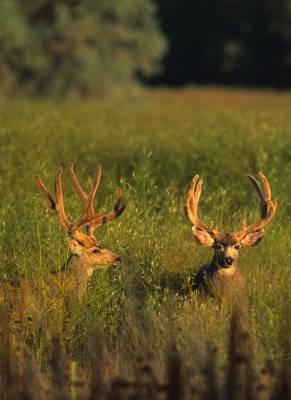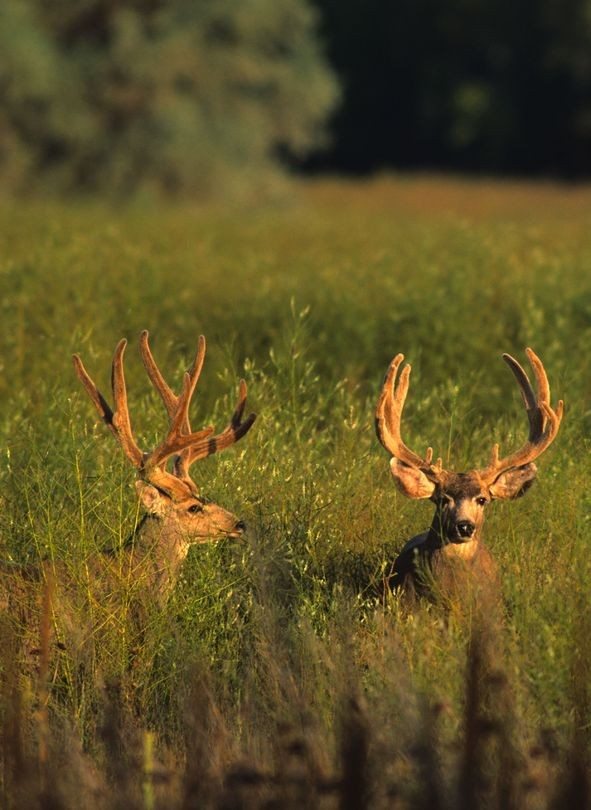
Spend enough time talking to good biologists, and you’ll learn that mule deer are creatures of the edge. By edge, I mean an area where older more mature plants and trees give way to younger developing plants. A biologist will usually refer to edge as secondary succession. These areas occur anywhere a disturbance- like a fire or a plow- has taken place. Mule deer gravitate to these areas because that is where their groceries grow.
Agriculture (Ag) ground often represents a place where edge is abundant and mule deer congregate. When I first started hunting big deer, I only wanted to hunt the farthest peak from the farthest road, but 30 years later, I’ve expanded my mind. Why? Well, reviewing my journal for 2012, five of the best bucks I saw last year were in and around Ag ground, compared to five I found in more traditional hunting country. By season’s end, I’d killed one high-country buck and one Ag buck, both grossing around 180″. If I wasn’t willing to scout and hunt Ag ground, my success rate would have been 50% lower.
My best Ag buck poised before some of the the country he called home.
Big bucks seek out seclusion, but not at the expense of highly nutritious food. While most Ag ground is far from remote, some of it still attracts bucks for several reasons.
1) Food. Ag ground produces many of the foods that mule deer like, like green alfalfa, young CRP grasses, corn, and a variety of other grains and seeds. These foods are highly nutritious, which fuels body weight and antler growth. They are also concentrated in relatively small areas, so deer don’t have to travel far.
2) Water. Ag ground usually has developed water either in ditches or irrigation pivots. Often, this is the key ingredient that is is attracting deer. In some places, before the water was developed, no mule deer existed as there was no water to sustain them.
3) Private property issues. A No-Trespassing sign is often a buck’s best friend, especially if the landowner isn’t a hunter himself or doesn’t notice the 30″ buck that sneaks into the field nightly but is gone by daylight. A buck can grow old around some Ag ground.
4) Most purist mule deer hunters won’t lower themselves to hunt Ag ground (I used to think this way). They prefer to grind off their knee cartilage at 10,000 feet carrying an 80-pound pack. This means some Ag bucks just don’t get hunted.
Some big Idaho Ag bucks that fed in the fields but bedded in the aspen during the day
Now I’m not saying that hunting Ag bucks is a picnic. You’ll often have company as some bucks are just too visible and the whole town will know they are there (I forget about those bucks and move on.) Also, some bucks just don’t leave the Ag ground if they have enough bedding cover. If you can’t get permission, they’re safe from you. However, if you scout and hunt smart, you might find a real hog buck that is huntable.
Consider that when the West was settled, the homesteaders took most of the flat plowable and irrigatable ground but left the steeper stuff to the government. In some places, this creates the edge that attracts mule deer. An alfalfa field that butts up against public ground full of coulees and washes will hold mule deer in most places. A golf course nestled in the Rocky Mountains almost always has a resident deer herd and sometimes a real toad.
Your job will be to find these areas and determine if the bucks are bedding in the cover on public ground where you can hunt them. I could tell you dozens of stories of good bucks that live this way. I’ve even killed a few. One 180″ Colorado buck comes to mind. I killed him on public 100 yards behind a house. From the kill site, I could see a bottle of Dawn dishsoap in the kitchen window with my naked eye.
If you want to kill a good buck in your lifetime, don’t rule out Ag bucks. I promise that if you get one on the ground, you will have either been very lucky or will have hunted hard, smart, and long- just like you have to anywhere.
This big Idaho buck was living in some aspen patches interspersed through some oat, barley, and CRP fields. That kind of food helps a buck grow maximum body weight and antlers. Photo courtesy of the internet.
I found this this 36″ 10×10 Idaho buck living in some sagebrush country that bordered some CRP and oat fields. While I never saw him in the fields during daylight hours, he lived there because the Ag ground provided food and water close to bedding areas. I hunted the buck eight days straight but another hunter killed him the first day he hunted the area. That is the downside to Ag bucks, sometimes you’re not the only hunter chasing them.
If you’ve ever killed or chased a big Ag buck, why do you think he was living there?





















Robby, I will bite. Hi, my name is Rich and I enjoy hunting ag bucks. I have found that at 48 my hunting habits are changing. My preference is hunting colorado Muleys on 2nd season vouchers while they are still in their summer mode high on the mountain. However, these tags are increasingly harder to draw. So I have adjusted my tactics accordingly. I have done my research and found 2 different ranches to hunt ag bucks in Colorado. I can draw these tags easily or purchase them a lot cheaper than the high price popular units.
I have a vested interest in letting these deer grow to maturity so I have become very picky. Don’t assume just because they are ag bucks that they are stupid. In fact,I know of several bucks that I know we’re living in a certain area and I could not find them at all during hunting hours. Old bucks are smart no matter how old they are. I have often found that during the 3rd season in Colorado bucks migrate in to the ag property from the high country.
I love the high country, but I am guessing quite a few bucks that grace the cover of our favorite magazines are ag bucks. You will find me this 3rd season hunting in colorado in unit 411 for a ag buck. Lotsa f opportunity if you are willing to work for it
Rich (lostinOregon)
Spot on Rich, “old bucks are smart…” and I agree we’d be surprised how many of the bucks on the mags are ag bucks. Thanks
My sons 1st buck bedded in the draws just outside of alfalfa field just had to wait for him to come out he was a 26″ 3×3. Keep up the good work on rock log Robby thanks
Comments are closed.